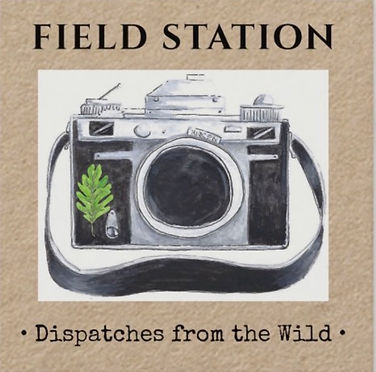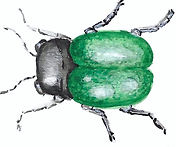




Listening Post
Immerse yourself in nature's symphony and let your senses burst with joy.
~Naturalist Tom Brown Jr.


[
]


SOUNDS IN NATURE
“We stop. Wait a minute. And listen. Aside from the distant echo of howling monkeys, the drips of rain from slippery leaf fronds, and the buzzing of insects, the only sound is the hushed rush of water from the river ahead. We stand still in the heat, beads of sweat carving paths down our faces. Sunlight streams through the dense canopy of coffee and rubber trees, casting shadows across the path. The scent of sweet jasmine fills the air. We are in a marvelous and mysterious tropical rainforest, just listening, waiting.”
“Carefully we take a step forward, pulling back branches, aware that each movement is thunderous to the ants below. And then as if the forest forgot we were there, a sound returns that captures our attention —a loud whistle. Aha! As we focus our eyes, we see it there on a log at the river’s edge, as yellow as a number 2 pencil and with inky black spots. It’s the rare Panamanian Golden Frog, the national animal of Panama. For such a tiny frog of only 3 1/2 inches, it sure makes a loud call as it searches for a mate. It’s very different from the green frogs I see back home. We are lucky to have snuck up on it. But that is how you find a frog, isn’t it? You are quiet, you wait, and you listen for its call.”
A excerpt from fictional “Listen,” a letter on frogs of the Panamanian Rainforest - Rachel Osborne
The Sound Around Us
We hear the birds chirping, the wind rustling leaves, the hum of insects, the drone of cars, a thunderous train, and the undulating buzz of an airplane. We often don’t pay much attention to sounds, much of which exists just as background noise as we go about our day. But it is clear that when we are immersed in the sounds of nature, it soothes us and restores a sense of calm in our lives. This state of being is called Green Mind, a phrase based on The Green Mind Theory that attempts to explain the positive connection between mind-body and our natural surrounding environment.
Science is still working to uncover these mysteries, but we already intuitively know that the rhythmic sounds of rain, wind, and insects mirror our body’s own biological rhythms, bringing down our frazzled energy state through a kind of synchronization with nature. But we aren’t the only ones who make use of the cacophony of sounds in the environment. Animals use sounds to communicate, to find mates, to send out alarm calls, and to hunt for food. Naturalist Sir David Attenborough tells us “The natural world is filled with sound and for some animals, sound is the key to survival.”
Soundscape Ecology
In recent history, a new branch of science has emerged to study the sounds we find in nature. Soundscape Ecology is a branch of science that seeks to understand how acoustic sounds, audible and inaudible to the human ear, exist in nature, how they are classified, the acoustic relationship between living and non-living things, and how human interactions affect them. Acoustic Ecology is often used interchangeably with soundscape ecology, however, soundscape ecology seeks to take a broader approach, going beyond the study of sounds detected just by the human ear, such as with the study of ultrasonic sound produced by bats. Scientists seek to determine how human-made sounds and other disruptions have a wide-ranging effect on living organisms’ ability to thrive. It is understood that damage from these sounds can occur due to the interruption of predator-prey interactions and mating rituals that rely on acoustic cues, and harm due to increased heart rate and breathing from stress, as well as from hearing loss. Additionally, it is an interesting question as to what extent the presence of invasive species and habitat destruction play in the soundscape environment.
Science of Soundscapes
Soundscapes are traditionally studied using recording devices and, more recently through the use of AI technology and spectrograms, to map soundscapes. Scientists study the distribution, diversity, and density of populations of organisms as well as their behavior in a given setting. Our understanding of ecology has deepened through these studies and has led to a new goal in conservation science, which is to protect natural soundscapes. The study of soundscapes can assist us, not only in understanding the relationship between human-made sounds and the environment but studies can also be an economical and efficient measurement tool to assess a habitat that has other kinds of alterations.
Terminology
Soundscape- the sounds that occur in a given area and time together, the acoustic relationship between living and non-living things, and the effects of human interactions on the sound environment, which are classified as biophonic, geophonic, or anthropophonic.
Bioacoustics- A scientific discipline that focuses on an individual species’ means of acoustic communication.
Landscape Ecology- A scientific discipline that characterizes landscapes and includes how landscapes can affect sound, like with echoes or with increased or decreased acoustics.
Sensory Ecology- a scientific study that includes how different organisms produce and perceive sound.
Acoustic Ecology- The study of sounds, detected by the human ear, in an environment.
The Niche Hypothesis- Scientists, seeking to understand the overlap of sounds in a natural environment, have proposed a theory that suggests that animals not only occupy a biological niche but also a niche of sound where there is minimal overlap of acoustic communication so that organisms are most advantaged in survival.
Acoustic Adaptive Hypothesis
Scientists theorize that interruptions in communication between biological organisms create a selective pressure to alter behavior. This can be through movement to a more advantageous environment or by changing vocalizations, behavior, or both. Not only can human interactions affect soundscapes but invasive species can also disrupt the sound environment.
Classification of Sound
Biophony- Sounds emitted by living organisms in nature in a given habitat at a given time, such as a bird call, the sound of crickets, or the sound of frogs croaking, for example.
Geophony- Sounds that are non-biological, such as from water, weather, wind, and fire.
Anthropophony- Sounds produced by humans or their activity- human voices, movement, and
human-made machines.
Keynotes- Sounds that we usually tune out and of which we are unaware.
Soundmarks- Sounds that are unique to a particular environment. It can be an indicator of a community.
From the beginning of our ability to record real life in sound and video to
forever preserve memories, artists have worked with recordings to
manipulate them into something new as is done with music in the studio
to add layers of sound to a song. Oppositely, sound artists also take
sounds and preserve them as a perspective of reality as documentarians
try to do. In both cases, artists use sound to tell a story.
Soundscape Artists Tell Stories
In modern times, soundscape artists and field recordists are seen in nature and the city creating things to say through sound. City recordists attempt to tell cultural stories from audio captured on city streets and to document the urban landscape for historical record. In nature, sound artists play with a variety of microphones and recording equipment, like paintbrushes, to reveal both familiar sounds and those that we’ve never heard before or to paint a picture of how sound changes over time. They sometimes also manipulate sounds in different ways so that we may hear aspects of sounds slowed down, sped up, or magnified in some way, for example, that leads us to appreciate nature from a new angle and ask ourselves “What do these sounds say to us?”
Sounds Connect Different Forms of Knowledge
Sound recording in nature can also be used to connect people to different forms of knowledge. Nature field recordists use environmental sounds to gather scientific data about living things to tell us about what’s happening in nature from a biological and conservation perspective, explaining the world around us and how it changes season to season and year to year, especially as our climate changes. Sound artists additionally explore sound in nature as a way to connect it to other things we know, like its similarity with music, to use it to paint visual representations in our minds, and also to create new links to language, mathematics, and different branches of science as we see sound as a way to describe experiences or as something to be measured.
Exploring Nature Through a Single Sense
We know, certainly, that bringing multiple senses into an experience creates a feeling of three-dimensionality. When we see and hear simultaneously, it creates a world in which we can be fully immersed. However, something interesting happens when one strips away other senses to focus on only one sense. It allows the brain to open itself up to a heightened experience, leading us to notice things we hadn't before. One is reminded of how pleasurable reading a novel can be because one can construct the scenes and characters from the imagination, having only the words on a page available. In another example, when we think of Picasso’s Blue Period, we are illuminated to find that his Blue study allowed him to find a greater depth of understanding in the subtle contours of shape, dimension, and mood in his art when only working with one color. I am also reminded, more humorously, that we "see" better when we turn down the radio as we search for a street address while driving our cars.
Ultimately, soundscape exploration teaches us to connect to nature more deeply and grow our appreciation and stewardship of it. To make these connections in a meaningful way, the sound artist hones a craft that requires considerable knowledge, skill, and artistry to share a story that desires to be told.
Reading and Reference
https://academic.oup.com/bioscience/article/61/3/203/238162
https://www.npr.org/transcripts/821648089
https://new.nsf.gov/news/studying-natures-rhythms-soundscape-scientists
https://storymaps.arcgis.com/stories/0662e88fb58a419f88375658ccfb37fe
https://www.sciencedirect.com/topics/earth-and-planetary-sciences/bioacoustics
https://www.nature.com/scitable/knowledge/library/principles-of-landscape-ecology-13260702/#:~:text=Landscape ecology is the study,spatial heterogeneity on these interactions.
https://www.nature.com/scitable/knowledge/library/perceptual-worlds-and-sensory-ecology-22141730/
https://naisa.ca/radio-art-companion/an-introduction-to-acoustic-ecology/
https://www.nps.gov/boha/learn/management/research-abstracts-ravenscraft.htm#:~:text=The acoustic niche hypothesis predicts,simultaneously at the same frequency.
https://direct.mit.edu/isal/proceedings/isal2020/32/465/98401
https://www.nature.com/articles/s41598-018-25359-y
https://www.allclassical.org/composers-on-nature/
https://www.ncbi.nlm.nih.gov/pmc/articles/PMC5551144/
https://www.aaas.org/news/how-human-made-noise-threatens-our-oceans
https://www.hiddenhearing.co.uk/hearing-blog/case-studies/the-top-10-animals-with-the-best-hearing
https://www.britannica.com/biography/Antonio-Vivaldi
https://www.phoenixsymphony.org/uploads/Classical.pdf
https://www.britannica.com/biography/Ludwig-van-Beethoven
https://www.classical-music.com/features/works/guide-beethovens-symphony-no-6-pastoral
https://www.britannica.com/biography/Claude-Debussy
https://interlude.hk/fairies-and-butterflies-in-the-salon-debussy-two-arabesques/
https://www.britannica.com/biography/Nikolay-Rimsky-Korsakov
https://study.com/learn/lesson/nikolai-rimsky-korsakov-flight-bumblebee-scheherazade.html
https://www.britannica.com/biography/Sergey-Rachmaninoff
https://oxfordsong.org/song/siren-2
https://www.allmusic.com/composition/lilacs-song-for-voice-piano-op-21-5-mc0002504512
https://www.britannica.com/biography/Camille-Saint-Saens
https://www.classicfm.com/composers/saint-saens/carnival-of-the-animals-guide/
https://www.britannica.com/biography/Frederic-Chopin
https://en.wikipedia.org/wiki/Prelude,_Op._28,_No._15_(Chopin)
https://www.britannica.com/biography/Richard-Wagner-German-composer
https://www.indianapolissymphony.org/backstage/program-notes/wagner-forest-murmurs/
https://www.britannica.com/biography/Johann-Sebastian-Bach
https://www.classicfm.com/composers/bach/yo-yo-ma-cello-suite-1-message/
https://acousticnature.com/journal/what-is-field-recording
”Field recording art” lecture-workshop with Yiorgis Sakellariou youtube.com
https://www.ncbi.nlm.nih.gov/pmc/articles/PMC7483614/
https://engineering.wustl.edu/news/2023/Mapping-soundscapes-everywhere.html
https://www.nature.com/articles/s41467-021-26488-1
Soundwalk activities
https://www.sensorytrust.org.uk/resources/activities/sound-activities
https://www.natureconservancy.ca/assets/documents/nat/nature-rx/NatureRx-soundwalk.pdf
https://atlanticcenterforthearts.org/event-or-exhibition/saturday-soundwalk-2/
SOUND AS ART


